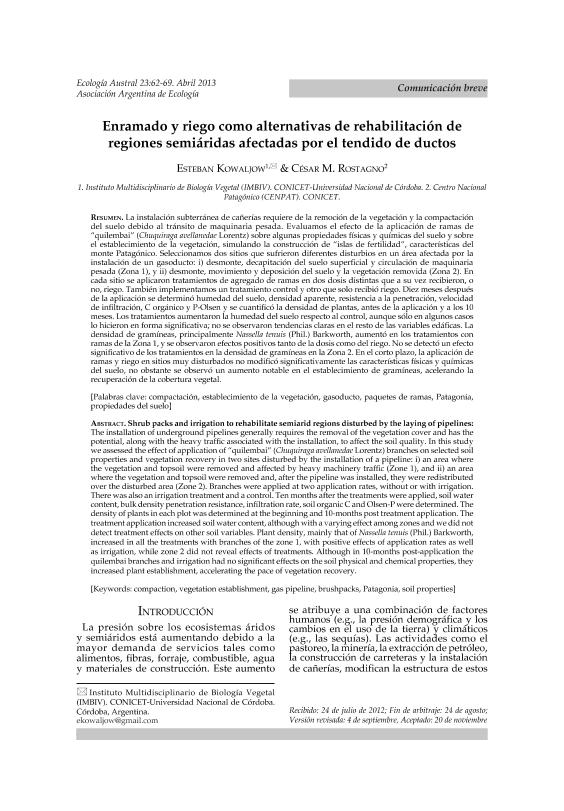Mostrar el registro sencillo del ítem
dc.contributor.author
Kowaljow, Esteban

dc.contributor.author
Rostagno, Cesar Mario

dc.date.available
2015-12-28T20:02:21Z
dc.date.issued
2013-04
dc.identifier.citation
Kowaljow, Esteban; Rostagno, Cesar Mario; Enramado y riego como alternativas de rehabilitación de regiones semiáridas afectadas por el tendido de ductos; Asociación Argentina de Ecología; Ecología Austral; 23; 1; 4-2013; 62-69
dc.identifier.issn
0327-5477
dc.identifier.uri
http://hdl.handle.net/11336/3257
dc.description.abstract
La instalación subterránea de cañerías requiere de la remoción de la vegetación y la compactación del suelo debido al tránsito de maquinaria pesada. Evaluamos el efecto de la aplicación de ramas de “quilembai” (Chuquiraga avellanedae Lorentz) sobre algunas propiedades físicas y químicas del suelo y sobre el establecimiento de la vegetación, simulando la construcción de “islas de fertilidad”, características del monte Patagónico. Seleccionamos dos sitios que sufrieron diferentes disturbios en un área afectada por la instalación de un gasoducto: i) desmonte, decapitación del suelo superficial y circulación de maquinaria pesada (Zona 1), y ii) desmonte, movimiento y deposición del suelo y la vegetación removida (Zona 2). En cada sitio se aplicaron tratamientos de agregado de ramas en dos dosis distintas que a su vez recibieron, o no, riego. También implementamos un tratamiento control y otro que solo recibió riego. Diez meses después de la aplicación se determinó humedad del suelo, densidad aparente, resistencia a la penetración, velocidad de infiltración, C orgánico y P-Olsen y se cuantificó la densidad de plantas, antes de la aplicación y a los 10 meses. Los tratamientos aumentaron la humedad del suelo respecto al control, aunque sólo en algunos casos lo hicieron en forma significativa; no se observaron tendencias claras en el resto de las variables edáficas. La densidad de gramíneas, principalmente Nassella tenuis (Phil.) Barkworth, aumentó en los tratamientos con ramas de la Zona 1, y se observaron efectos positivos tanto de la dosis como del riego. No se detectó un efecto significativo de los tratamientos en la densidad de gramíneas en la Zona 2. En el corto plazo, la aplicación de ramas y riego en sitios muy disturbados no modificó significativamente las características físicas y químicas del suelo, no obstante se observó un aumento notable en el establecimiento de gramíneas, acelerando la recuperación de la cobertura vegetal
dc.description.abstract
The installation of underground pipelines generally requires the removal of the vegetation cover and has the potential, along with the heavy traffic associated with the installation, to affect the soil quality. In this study we assessed the effect of application of “quilembai” (Chuquiraga avellanedae Lorentz) branches on selected soil properties and vegetation recovery in two sites disturbed by the installation of a pipeline: i) an area where the vegetation and topsoil were removed and affected by heavy machinery traffic (Zone 1), and ii) an area where the vegetation and topsoil were removed and, after the pipeline was installed, they were redistributed over the disturbed area (Zone 2). Branches were applied at two application rates, without or with irrigation. There was also an irrigation treatment and a control. Ten months after the treatments were applied, soil water content, bulk density penetration resistance, infiltration rate, soil organic C and Olsen-P were determined. The density of plants in each plot was determined at the beginning and 10-months post treatment application. The treatment application increased soil water content, although with a varying effect among zones and we did not detect treatment effects on other soil variables. Plant density, mainly that of Nassella tenuis (Phil.) Barkworth, increased in all the treatments with branches of the zone 1, with positive effects of application rates as well as irrigation, while zone 2 did not reveal effects of treatments. Although in 10-months post-application the quilembai branches and irrigation had no significant effects on the soil physical and chemical properties, they increased plant establishment, accelerating the pace of vegetation recovery
dc.format
application/pdf
dc.language.iso
spa
dc.publisher
Asociación Argentina de Ecología

dc.rights
info:eu-repo/semantics/openAccess
dc.rights.uri
https://creativecommons.org/licenses/by/2.5/ar/
dc.subject
Compactación
dc.subject
Establecimiento de La Vegetación
dc.subject
Gasoducto
dc.subject
Paquetes de Ramas
dc.subject
Patagonia
dc.subject
Propiedades del Suelo
dc.subject.classification
Ecología

dc.subject.classification
Ciencias Biológicas

dc.subject.classification
CIENCIAS NATURALES Y EXACTAS

dc.title
Enramado y riego como alternativas de rehabilitación de regiones semiáridas afectadas por el tendido de ductos
dc.title
Shrub packs and irrigation to rehabilitate semiarid regions disturbed by the laying of pipelines
dc.type
info:eu-repo/semantics/article
dc.type
info:ar-repo/semantics/artículo
dc.type
info:eu-repo/semantics/publishedVersion
dc.date.updated
2016-03-30 10:35:44.97925-03
dc.identifier.eissn
1667-782X
dc.journal.volume
23
dc.journal.number
1
dc.journal.pagination
62-69
dc.journal.pais
Argentina

dc.journal.ciudad
Córdoba
dc.description.fil
Fil: Kowaljow, Esteban. Consejo Nacional de Investigaciones Científicas y Técnicas. Centro Científico Tecnológico Córdoba. Instituto Multidisciplinario de Biología Vegetal (p); Argentina
dc.description.fil
Fil: Rostagno, Cesar Mario. Consejo Nacional de Investigaciones Científicas y Técnicas. Centro Nacional Patagónico; Argentina
dc.journal.title
Ecología Austral

dc.relation.alternativeid
info:eu-repo/semantics/altIdentifier/url/http://www.scielo.org.ar/scielo.php?script=sci_arttext&pid=S1667-782X2013000100008
dc.relation.alternativeid
info:eu-repo/semantics/altIdentifier/url/https://ojs.ecologiaaustral.com.ar/index.php/Ecologia_Austral/article/view/1193
dc.relation.alternativeid
info:eu-repo/semantics/altIdentifier/doi/https://doi.org/10.25260/EA.13.23.1.0.1193
Archivos asociados
